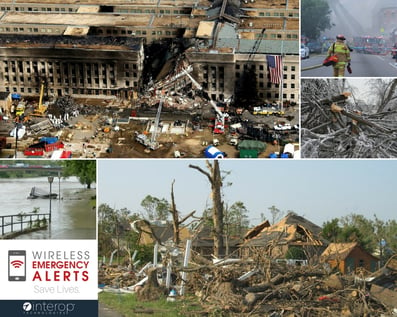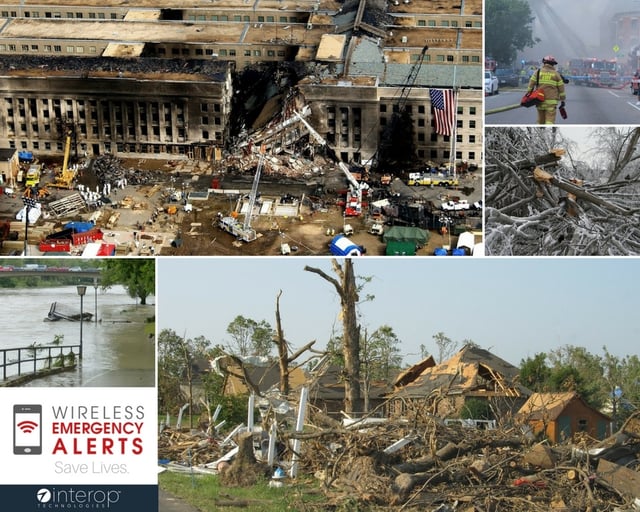Nearly 30 years ago, the Federal Communications Commission (FCC) and the wireless trade association CTIA, started a conversation about the need for wireless location-based services. It wasn’t until 1988 that the FCC agreed on the ruling to require wireless carriers to enable subscriber location tracking through cell towers to be used for emergency response systems— and it would take yet another 10 years before we saw the advent of the “text message” and another 14 years for emergency alerting to become what it is today in our hyper-mobile world.
The Wireless Emergency Alerts (WEA) system was officially launched in June of 2012 to provide a standardized way for public safety officials to deliver text message warnings to the public during an emergency. Within a few months of launching the WEA system, several news stories highlighted its success. These stories told of hundreds of kidnapped children being recovered, towns avoiding severe weather disasters and the public assisting in the capture of a bombing suspect during an unprecedented manhunt. By October of 2013, 98% of wireless consumers in the U.S. were actively participating in the WEA initiative, stated Christopher Guttman-McCabe, who was executive vice president of CTIA at the time.[1]
 However with wireless technology advancing at such an extraordinary rate these days, the WEA systems’ capabilities have quickly become outdated. Especially in regards to the need for more accurate geo-targeting capabilities, which would reduce inaccuracies and eliminate the risk of over alerting the public and causing mass panic. Another needed capability is a way to provide more in-depth information about an emergency, which has been hard to do with the 90-character limit and inability to include images or embed links. Yet big brands like Sephora, JetBlue, Whole Foods and Uber (only to name a few) have been able to implement these technology advancements to drive products and services sales through location-based mobile ads and push notifications. So why isn’t this same technology being used for public safety? This is partly due to the disparate opinions of the wireless industry; some who have been reluctant to accept the FCC’s proposed regulation to improve WEA and those who are fighting to improve its capabilities.
However with wireless technology advancing at such an extraordinary rate these days, the WEA systems’ capabilities have quickly become outdated. Especially in regards to the need for more accurate geo-targeting capabilities, which would reduce inaccuracies and eliminate the risk of over alerting the public and causing mass panic. Another needed capability is a way to provide more in-depth information about an emergency, which has been hard to do with the 90-character limit and inability to include images or embed links. Yet big brands like Sephora, JetBlue, Whole Foods and Uber (only to name a few) have been able to implement these technology advancements to drive products and services sales through location-based mobile ads and push notifications. So why isn’t this same technology being used for public safety? This is partly due to the disparate opinions of the wireless industry; some who have been reluctant to accept the FCC’s proposed regulation to improve WEA and those who are fighting to improve its capabilities.
Several government agencies, public officials, scientists, technologists and developers met last year to discuss updating the WEA system. In September 2016, the Federal Communications Commission (FCC) announced it had adopted new rules to enhance and strengthen WEA and develop a testing program to improve its effectiveness. The updated rules included the following[2]:
- Increase the length of WEA messages from the current 90 characters to up to 360 characters for subscribers on 4G, LTE and beyond.
- Support for the inclusion of embedding phone numbers and Internet addresses to provide additional information and resources for alerts.
- Improve the geographic ability of WEA alerts to narrow alert areas.
- Create “Public Safety Messages” to provide critical, suggested actions to assist in saving life or property.
- Support for the transmission of Spanish-language alerts
- Provide simpler ways for state and local authorities to test the alerting system, train staff and raise public awareness of the service.
The FCC’s timeline for implementing these enhancements has been met with some hesitation from carriers and wireless groups. At the time of its release, CTIA stated, “While we support efforts to enhance this important voluntary system, we are concerned that the FCC’s technically unrealistic timeline adopted today may impede the delivery of emergency alerts.”
Due to the fact that WEA is a voluntary program, the FCC cannot force carriers to participate. Yet the system and its proposed improvements are about public safety and not providing this service puts US citizens at risk when they are most vulnerable. If anything, events over the last year should prove that the benefits of these updates far surpass the costs of implementing them. It’s been a really rough year for countless Americans who have experienced devastating weather conditions that have resulted in 282 deaths[3]. Damaging wildfires in the West, droughts in the Mid-West, record-breaking hurricanes and tropical storms in the South, severe freezing in many Central, Eastern and Northeastern states, and tornados in the Southern Plain states, along with flooding, hail storms, and more[4].

As a leader in providing cloud-based managed services to Commercial Service Providers, Interop Technologies has been committed to helping wireless carriers quickly implement and easily adhere to WEA regulations and compliance. We believe that together, we can help make our country safer during an emergency.
If you’re a mobile subscriber looking for more information on WEA, check out FEMA’s frequently asked questions here.
- Powerful Wireless Emergency Alerts Success Stories at Congressional Hearing [Retrieved Nov. 8, 2017].
- [2] FCC Press Release[Retrieved Nov. 15, 2017]


